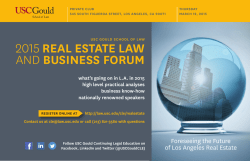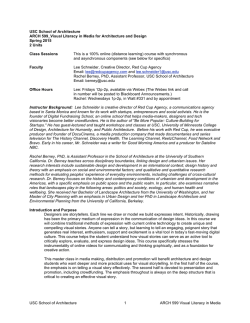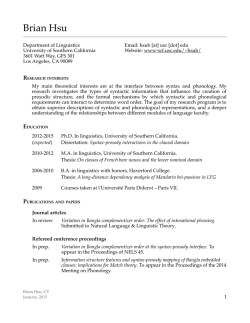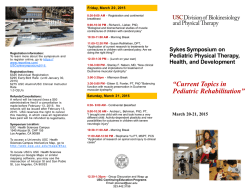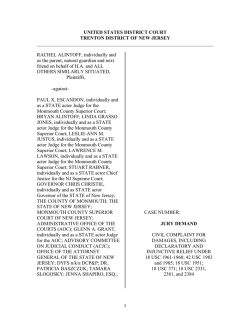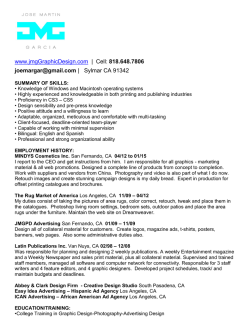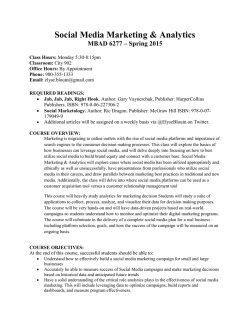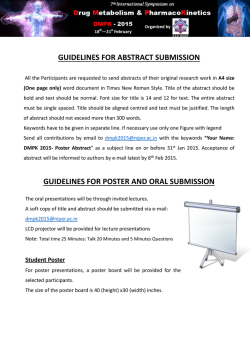
CMGT 400: Marketing Communication Campaigns Spring 2015
CMGT 400 Syllabus CMGT 400: Marketing Communication Campaigns Spring 2015 Class: Thursday, 2:00-5:00 in ANN L115 Professor: Andrea Hollingshead Office: 414L ANN (New Annenberg Building) Office hours: By appointment Email: [email protected] Course description Successful marketing communication campaigns communicate consumer benefits in simple, unexpected and compelling ways. This course provides an overview and application of marketing communication principles and strategies. It focuses on the steps involved in creating and managing an integrated marketing communication plan. You will work as a marketing communication consulting team for a local business or organization and will produce and present a marketing communication and advertising plan that meets strategic objectives. I will use a new instructional method called the “flipped classroom”. You will view multimedia lecture content before class. This means we’ll be able to spend class time on discussions, class activities and team project meetings rather than lectures. For this method to work, it is absolutely essential that you come prepared for class. (See class quizzes and optional exam below.) Learning objectives The overall objective of the course is to design, construct, and present an integrated marketing communication plan for a local business or organization. These are the specific learning objectives: Develop an awareness and appreciation of ethical pitfalls in marketing communications Write a compelling brand challenge statement Perform a situation analysis and competitive analysis Perform a SWOT analysis Analyze current integrated communications, outlining suggestions for improvement and highlighting strengths and weaknesses. Conduct qualitative interviews & in-store observations Create a target audience profile and communication objectives for a campaign Create actual marketing communications and advertising based on campaign strategy Create an integrated media plan that combines traditional and social media to deliver the intended message Develop a campaign evaluation plan Utilize web-based tools to create professional quality marketing communications 1 CMGT 400 Syllabus Textbooks and materials Four of the five books are available in Kindle versions on amazon.com. That seems to be the least expensive option. You can download the kindle cloud reader for free, install and read the books on any or all of your devices. Paperbacks are available at the USC Bookstore and via online sellers. Books: Barry, P. (2012). The advertising concept book: A complete guide to creative ideas, strategies, and campaigns. New York: Thames & Hudson. ISBN: 978-0500290316 (No electronic version. Available at USC bookstore.) Coughter, P. (2012). The art of the pitch: Persuasion and presentation skills that win business. Palgrave Macmillan. ISBN: 978-0230120518 (E-version is available) Heath, C & Heath, D. (2007).Made to stick: Why some ideas die and others survive. Random House. ISBN:978-1400064281 (E-version is available.) Vaynerchuk, G. (2013) Jab. Jab. Right hook. How to tell your story in a noisy social world. Harper Collins. ISBN: 978-0062273062 (E-version is available.) Young, A. (2010). Brand media strategy: Integrated communications planning in the digital era. Palgrave Macmillan. ISBN: 978-0230104747. (E-version is available) Other Materials: There are two required video episodes. Amazon tends to be cheaper than iTunes ($1.99 vs. $2.99). “The Pitch” Season 1, Episode 1: “Subway” http://www.amazon.com/Subway-McKinney-WDCW/dp/B009LAHDIC “The Pitch” Season 2, Episode 4: “Tommy Bahama” http://www.amazon.com/Tommy-Bahama/dp/B00F0LH6Z6 Articles and Multimedia Presentations: See the “Weekly Readings” list at the end of this document for a complete list. The articles and multimedia presentations are free and will be posted on the Blackboard site. *Be sure to check our class Blackboard site every day for class announcements. I post announcements several times a week through out the semester on class news and other developments. You are responsible for keeping up to date. https://blackboard.usc.edu/ 2 CMGT 400 Syllabus Grading policy Course components Component 1. Individual Response Papers 2. Team Marketing Communication Plan 3. What’z Newz 4. Class Participation & Peer Evaluation 5. Class Quizzes and Optional Exam Total Percentage Percentage of Final Grade 30% 40% 10% 10% 10% 100% Individual Response Papers (30%) There are three individual response papers based on three of the books in the course: 1) The Art of the Pitch; 2) Made to Stick; 3) Jab Jab Jab Right Hook. Get started early, because late assignments will not be accepted. Team Marketing Communication Plan (40%) The course is organized around steps involved in creating and presenting an effective integrated marketing communication plan for a local business. This is a semester-long team project. During finals week at the time when our final exam is scheduled, your team will present your marketing communication plan (along with sample creative executions) and will submit a final written report to your client. The final presentation will be in a video format with a live Q & A session. The video format has many advantages including the ability for you and your client to share it. The midterm presentation (video) is worth 5%, the final presentation (video) is worth 15%; the midterm report is worth 5%, the final report is worth 15%. The final presentation dress rehearsal on the last day of class is ungraded but there will be a significant penalty for your team project grade for missing it. Attendance on dress rehearsal and final presentation days are mandatory. Missing class, arriving late or leaving early on those days will result in a one full grade penalty in your class participation grade. Your team will also make two required checkpoints (ungraded, but points will be deducted from the team project grade if not completed on time). One will be on your consumer research observation procedures and interview questions, and the other will be on your creative big idea. I expect all members to contribute equally to the team project. The highest possible individual grade is the group project grade. If you contribute less than other members, your individual grade will be lower than the group grade. At the end of the semester, you will have the opportunity to evaluate the performance of 3 CMGT 400 Syllabus your team members, and I will consult those evaluations in determining your individual grades for the group project. What’z Newz Presentation (10%) Every class will begin with “What’z Newz,” an opportunity to present and discuss current issues and innovations in marketing communication. Each of you will sign up for a week and will lead a 10-15 min discussion on the topic of your choice, which must relate in some way to marketing communication. You have two goals: 1) to engage and entertain your audience; and 2) to educate your audience and examine the topic from multiple perspectives. Ten minutes is not much time. Spend about 5 min presenting the topic, and the rest on discussion. In addition to presenting the topic, you will lead a short discussion, and will post 1) your slides and 2) one page overview of your topic, discussion questions and references under “Assignments” on the course blackboard site by noon on the day you are presenting. See below for the dress code. Prepare two or three open-ended questions that will generate an interesting discussion. The questions should be provocative, and explore the issue in more detail. Here are a few sites to check out if you need inspiration: Ad Age, Ad Week, Brandweek, Creativity Ad Critic, Fast Company, iMedia Connection, Mashable, NYTimes Monday Tech section. Class Participation and Peer Evaluation (10%) Much of the class is discussion-based. The quality of our discussion hinges on your contributions and those of your classmates. I will keep track of the frequency and quality of your comments, which will count toward your participation grade. Texting, engaging in social media, or surfing the web during class is disruptive, which will result in a penalty. Giving and receiving constructive and useful feedback is an integral part of the team project. There will be a few opportunities for you to give formal feedback to other teams: midterm, creative big idea presentations, dress rehearsal. The quality of your feedback will also play a role in this component of our grade. Here are two good sources on tips to giving and receiving feedback. https://uwaterloo.ca/centre-for-teaching-excellence/teaching-resources/teachingtips/assessing-student-work/grading-and-feedback/receiving-and-giving-effectivefeedback http://www.fastcompany.com/magazine/80/sgodin.html Class Quizzes and Optional Exam (10%) To help ensure that the class has viewed the assigned materials, I will give unannounced short pop quizzes on some days of the semester. The quiz will be very easy if you are prepared, and is not a big deal. The class will take the quiz anonymously, and I will calculate a class score. There will be an optional individual exam at the end of the semester for those who want to improve their 4 CMGT 400 Syllabus grade. I will take whichever score is higher: your individual score or class quiz score for this component of the grade. Digital Technologies One of the most important skills you can gain during your time at USC Annenberg is the ability to present content effectively in a digital format. Annenberg’s partnership with Adobe gives you free access to the Adobe Creative Cloud. The digital lab at Annenberg (301 ANN) offers free workshops on using Adobe applications, and can answer your digital tech-related questions. I posted a digital technologies tool box with free innovative applications on course blackboard. As a USC student, you have free access to Lynda.com, which offers video tutorials for most digital technologies. http://itservices.usc.edu/lynda/ Take advantage of these resources! Grade Ranges Grade A AB+ B BC+ C CD F Range 93.0% or higher 90.0%-92.9% 87.0%-89.9% 83.0%-86.9% 80.0%-82.9% 77.0%-79.9% 73.0%-76.9% 70.0%-72.9% 60.0%-69.9% 59.9% or lower Paper General Guidelines All documents should be in pdf format. All page length requirements are for double-spaced pages, with 1-inch margins, in 12-point Times New Roman font. Make sure you keep a copy of all submitted papers. Use APA style. Refer to the APA manual (6th Edition). Poor grammar, typos and other writing errors will be penalized. Presentation Dress Code The dress code when you are making a formal presentation (i.e., What’z newz, midterm, dress rehearsal, final client presentation) is business casual. That means no shorts, short skirts, low cut tops or dresses, t-shirts, jeans, flip flops, or sneakers. Not adhering to this code will result in a penalty in your grade. 5 CMGT 400 Syllabus Laptop policy Effective fall 2014, all undergraduate and graduate Annenberg majors and minors will be required to have a PC or Apple laptop that can be used in Annenberg classes. Please refer to the Annenberg Virtual Commons for more information. To connect to USC’s Secure Wireless network, please visit USC’s Information Technology Services website. Academic integrity policy USC School of Communication Policy on Academic Integrity The following is the USC Annenberg School of Communication’s policy on academic integrity and repeated in the syllabus for every course in the school: USC seeks to maintain an optimal learning environment. General principles of academic honesty include the concept of respect for the intellectual property of others, the expectation that individual work will be submitted unless otherwise allowed by an instructor, and the obligations both to protect one’s own academic work from misuse by others as well as to avoid using another’s work as one’s own. All students are expected to understand and abide by these principles. SCampus, the Student Guidebook, (www.usc.edu/scampus or http://scampus.usc.edu) contains the University Student Conduct Code (see University Governance, Section 11.00), while the recommended sanctions are located in Appendix A. All academic integrity violations will be reported to the office of Student Judicial Affairs & Community Standards (SJACS), as per university policy, as well as Communication school administrators. In addition, it is assumed that the work you submit for this course is work you have produced entirely by yourself, and has not been previously produced by you for submission in another course or Learning Lab, without the instructor’s prior approval. It is particularly important that you are aware of and avoid plagiarism, cheating on exams, fabricating data for a project, submitting a paper to more than one professor, or submitting a paper authored by anyone other than yourself. If you have doubts about any of these practices, confer with a faculty member. Resources on academic honesty can be found on the Student Judicial Affairs Web site (http://www.usc.edu/student-affairs/SJACS ): You are responsible for knowing about and abiding by university guidelines. All submitted work for this course may be subject to an originality review as performed by TurnItIn technologies (http://www.turnitin.com) to find textual similarities with other Internet content or previously submitted student work. Students of this course retain the copyright of their own original work, and TurnItIn is not permitted to use student-submitted work for any other purpose 6 CMGT 400 Syllabus than (a) performing an originality review of the work, and (b) including that work in the database against which it checks other student-submitted work. IMPORTANT! Any team or individual assignment that receives a high plagiarism score will receive a failing grade of 0. Any student who receives a high plagiarism score on two assignments will receive an F grade in the course. B. Statement for Students with Disabilities Any student requesting academic accommodations based on a disability is required to register with Disability Services and Programs (DSP) each semester. A letter of verification for approved accommodations can be obtained from DSP. Please be sure the letter is delivered to me (or to TA) as early in the semester as possible. DSP is located in STU 301 and is open 8:30 a.m.–5:00 p.m., Monday through Friday. Website and contact information for DSP: http://sait.usc.edu/academicsupport/centerprograms/dsp/home_index.html, (213) 740-0776 (Phone), (213) 740-6948 (TDD only), [email protected]. C. Stress Management Students are under a lot of pressure. If you start to feel overwhelmed, it is important that you reach out for help. A good place to start is the USC Student Counseling Services office at 213-740-7711. The service is confidential, and there is no charge. D. Sexual Assault Resource Center The Center for Women & Men and the Sexual Assault Resource Center are one and the same. Student Counseling Services is a separate place that also offers confidential counseling and support groups on a variety of other topics. To schedule an appointment with Student Counseling Services, call (213) 740-7711 between 8:30 a.m. and 5 p.m. weekdays or visit the Engemann Student Health Center on the University Park Campus. E. Emergency Preparedness/Course Continuity in a Crisis In case of a declared emergency if travel to campus is not feasible, USC executive leadership will announce an electronic way for instructors to teach students in their residence halls or homes using a combination of Blackboard, teleconferencing, and other technologies. Library access As a USC student, you have access to all the library resources and the Annenberg Librarian, Chimene Tucker ([email protected]), is available to assist you with any inquiry you may have. http://libguides.usc.edu/communication/ 7 CMGT 400 Syllabus Course Schedule and Topics Week 1: Course Introduction Week 2: Marketing Communication Ethics Week 3: Pitching Ideas & Team Projects Week 4: Branding and Situation Analysis Week 5: Consumer Research Week 6: Consumer Research Week 7: Communication Objectives Week 8: Team Midterm Presentation and Report Week 9: Creative Strategy Week 10: SPRING BREAK – NO CLASS Week 11: Creative Strategy Week 12: Big Idea Creative Pitches Week 13: Media Strategy Week 14: Media Strategy & Promotions Week 15: Marketing Communication Campaign Evaluation Week 16: Last Day and Dress Rehearsal for Client Presentations (Mandatory Class) Final Client Presentations & Reports Due: Thursday, May 7 from 2:00-4:00pm Weekly Readings & Assignments Week 1 (Jan 15) Course Introduction Week 2 (Jan 22) Multimedia presentations on blackboard *Young, A. (2010). Brand media strategy: Integrated communications planning in the digital era. Chapters 1. (TEXT) *Barry, P. (2012). The advertising concept book: A complete guide to creative ideas, strategies, and campaigns. Chapters Introduction, 1,12, 15 (TEXT) *Spirizzi, M. Online advertising ethics. .http://advertising.about.com/od/onlineadvertising/a/guestethicalads.htm *Elliot, S. & Vega, T. (2013). Trying to be hip, ads become offensive. http://www.nytimes.com/2013/05/11/business/media/trying-to-be hipand-edgy-ads-become-offensive.html?smid=pl-share 8 CMGT 400 Syllabus Week 3 (Jan 29) *Coughter,P. (2012). The art of the pitch: Persuasion and presentation skills that win business. Palgrave Macmillan. *"'The Pitch" episodes: Subway and Tommy Bahama Paper 1 due: January 28 by 11:59pm (Submit via blackboard) Week 4 (Feb 5) *Multimedia presentations on blackboard *Young, A. (2010). Brand media strategy: Integrated communications planning in the digital era. New York: Palgrave Macmillan. Chapters 5, 6. *Igor Naming Guide (2005) *Whitfill, A. (2009). Burts Bees, Tom's of Maine, Naked Juice. Your favorite brands -- take a look again. They aren't what they seem. Alternet.org. (Mar 17). Retrieved from http://www.alternet.org/ story/131910/ *Segal, D. (2014, July 27) . For coconut waters, A street fight for shelf space. New York Times. Retrieved from: http://nyti.ms/1nHvMyb *O’Brien, K. (2012, May 4). How McDonald’s came back bigger than ever. New York Times. Retrieved from http://www.nytimes.com/2012/05/06/magazine/how-mcdonalds-came-backbigger-than-ever.html?smid=pl-share Week 5 (Feb 12) *Multimedia presentations in this folder *Young, A. (2010). Brand media strategy: Integrated communications planning in the digital era. New York: Palgrave Macmillan. Chapter 5-6. *Fowler, F. (1997). Chapter 2: Designing survey questions to gather factual data. Improving survey questions: Design and Evaluation. (Optional) Week 6 (Feb 19) *Multimedia presentations in this folder *Clifford, S. (2012). Social media as focus groups. (July 30). http://www.nytimes.com/2012/07/31/technology/facebook-twitter-andfoursquare-as-corporate-focus-groups.html?_r=1&hpw *Duhigg, C. (2012) How companies learn your secrets. New York Times. (Feb 19.) Retrieved fromhttp://www.nytimes.com/2012/02/19/magazine/shopping-habits.html *Goel, V. (2014). How Facebook sold you krill oil. New York Times. (Aug 2) http://nyti.ms/1ojcY4c *Young, A. (2010). Brand media strategy: Integrated communications planning in the digital era. New York: Palgrave Macmillan. Chapter 6. Week 7 (Feb 26) Schwartzapfel, S. (2012). Real “Mad Men” Pitched Safety to Sell Volvos.(Apr 23) http://www.nytimes.com/2012/03/25/automobiles/real-mad-men-pitchedsafety-to-sell-volvos.html Week 8 (Mar 5) Midterm presentations and reports. No reading. (Mandatory class) Week 9 (Mar 12) *Heath, C & Heath, D. (2007).Made to stick: Why some ideas die and others survive. Random House *Barry, P. (2012). The advertising concept book: A complete guide to creative ideas, strategies, and campaigns. New York: Thames & Hudson. Chapter 8. (text) 9 CMGT 400 Syllabus *Paper 2 due: Mar 11 by 11:59pm Week 10 (Mar 19) SPRING BREAK – NO CLASS Week 11 (Mar 26) *Multimedia presentations on blackboard. *The Whopper Freakout Case Study on blackboard * View the video on creative briefs from the perspective of famous creative executives: http://bassett.tv/briefly/search Week 12 (Apr 2) *Pitch your “big creative ideas” for feedback. *For inspiration, watch how different agencies present their creative ideas on “The Pitch” http://www.amctv.com/full-episodes/the-pitch *Young, A. (2010). Brand media strategy: Integrated communications planning in the digital era.. Chapters 8, 10, 11, 12. *Barry, P. (2012). The advertising concept book: A complete guide to creative ideas, strategies, and campaigns. Chapter 8, 9. Week 13 (Apr 9) *Vaynerchuk, G. (2013). Jab. Jab. Jab. Right hook. How to tell your story in a noisy social world. (Text) *Paper 3 Due: April 8 by 11:59pm Week 14 (Apr 16) *Mutlimedia presentations on blackboard *Young, A. (2010). Brand media strategy: Integrated communications planning in the digital era. Chapters 8, 10, 11, 12. (Text) *Barry, P. (2012). The advertising concept book: A complete guide to creative ideas, strategies, and campaigns. Chapter 9. (text) *Steinberg, B. (2009). The future of tv. Advertising Age. (Nov 30). Retrieved from http://adage.com/article/mediaworks/future-tv/140751/ *Wikipedia page on online advertising (click and read the links on specific types of online advertising.) Retrieved fromhttp://en.wikipedia.org/wiki/Online_advertising *Shaoolian, G. (2011) Why a mediocre website is so dangerous. New York Times. (Nov 29). Retrieved fromhttp://boss.blogs.nytimes.com/ 2011/11/29/why-a-mediocre-web-site-is-so-dangerous *Hagen, J. (2011). Tweet science. New York Magazine. (Oct 2). Retrieved from http://nymag.com/news/media/twitter-2011-10/ *Native advertising with John Oliver. http://youtu.be/E_F5GxCwizc *On facebook ad types: http://socialfresh.com/facebook-ad-types/ Week 15 (Apr 23) Multimedia presentations on blackboard Week 16 (Apr 30) Last Day Dress rehearsal videos + Q & A (Mandatory class) No reading Final Client Presentations and Reports are due on May 7 2:99-4:00pm 10
© Copyright 2025
